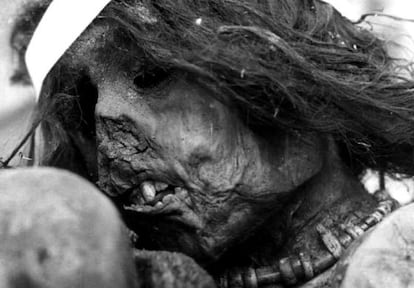Child sacrificed by Incas 500 years ago sheds light on Americans’ origins
DNA samples support thesis that humans first crossed the Bering Strait 15,000 years ago

One day, around the year 1500, a group of people walked up the slopes of the highest peak in the Americas, Aconcagua, in what is today Argentina. They were Incas and were taking a seven-year-old boy chosen for his beauty and good health up to the 5,300-meter summit, where they then sacrificed him with a blow to the head.
The results show that the boy belonged to a human line created around 14,300 years ago that no longer exists
Almost five centuries later, on January 8, 1985, five Argentinean climbers came across a pile of bones and feathers sticking out of the ice on Aconcagua. They first thought it was the remains of a condor, but they soon realized it was a young boy. His body had been decorated with feathers and he had been buried with six small gold statues of men and llamas.
Three decades after the find, the sacrificed boy has begun to yield some of his secrets. A team led by Spanish geneticist Antonio Salas, of the University of Santiago de Compostela, has read the child’s DNA and compared it to a database of around 28,000 genomes. The results show that the boy belonged to a human line created around 14,300 years ago that no longer exists. The research supports the latest genetic studies of modern-day Americans and the skeletons of their ancestors, which show that the first humans to enter America did so around 15,000 years ago via Siberia.

Salas’ team has not read the mummy’s nuclear genome, the instruction manual present in the nucleus of each of our cells, but rather the residual DNA present in mitochondria, the batteries that provide energy to our cells. Mitochondrial DNA is inherited from our mothers and is a very useful way of establishing if two people are related. “The lineage of this child were people who came to America from the north, and who evolved and then disappeared, which is not so surprising, because the majority of Incas died when they came into contact with Europeans, typically from diseases such as measles, flu, smallpox, and diptheria,” says Salas.
Scientists can create a picture of the past by comparing genomes, in much the same way that it’s possible to sort hundreds of manuscript Bibles into chronological order by comparing their accumulated mistakes. In July, a different team, led by geneticist Eske Willerslev of Copenhagen University, reached the conclusion that the first Americans came from a group that left Siberia 23,000 years ago and were trapped for a further 8,000 years in Beringia, a small piece of land that used to exist as a bridge between Russia and the northwestern United States, in what is today the Bering Strait.
“All of America’s different genetic varieties come from the incubation in the Bering Strait, and entered in different waves. The maternal lineage of the Inca child dates back 18,000 years, and the mummy is a branch,” says Salas. This is the first time that the entire mitochondrial genome of an American mummy has been read, say the team, which has published its work in Scientific Reports magazine.
The researchers, among them Federico Martinón Torres of the University of Santiago’s Clinical Hospital, used a small sample taken from the child’s lung. The complete mummy “remains under the custody of the National University of Cuyo, in Argentina, frozen at -20ºC, but its exact location is a secret,” says Salas.
The researchers’ next objective is to analyze the mummy’s entire genome and, above all, its microbiome: the DNA of the microorganisms that lived inside the child and that might have changed after the arrival of the Europeans and their diseases.
The Inca child, known in Argentina as “the Aconcagua mummy” was sacrificed as part of Capacocha, an Inca ceremony carried out around harvest time that included offerings to the sun or the emperor at times of sickness. Healthy, attractive children were slaughtered in the hope that their energy would be transmitted to the Inca.
Tu suscripción se está usando en otro dispositivo
¿Quieres añadir otro usuario a tu suscripción?
Si continúas leyendo en este dispositivo, no se podrá leer en el otro.
FlechaTu suscripción se está usando en otro dispositivo y solo puedes acceder a EL PAÍS desde un dispositivo a la vez.
Si quieres compartir tu cuenta, cambia tu suscripción a la modalidad Premium, así podrás añadir otro usuario. Cada uno accederá con su propia cuenta de email, lo que os permitirá personalizar vuestra experiencia en EL PAÍS.
¿Tienes una suscripción de empresa? Accede aquí para contratar más cuentas.
En el caso de no saber quién está usando tu cuenta, te recomendamos cambiar tu contraseña aquí.
Si decides continuar compartiendo tu cuenta, este mensaje se mostrará en tu dispositivo y en el de la otra persona que está usando tu cuenta de forma indefinida, afectando a tu experiencia de lectura. Puedes consultar aquí los términos y condiciones de la suscripción digital.
Últimas noticias
The complicated life of Francesca Albanese: A rising figure in Italy but barred from every bank by Trump’s sanctions
How Japan is trying to avert ‘digital defeat’
Half of Scotland is in the hands of 420 property owners
Reinhard Genzel, Nobel laureate in physics: ‘One-minute videos will never give you the truth’
Most viewed
- Pablo Escobar’s hippos: A serious environmental problem, 40 years on
- Why we lost the habit of sleeping in two segments and how that changed our sense of time
- Charles Dubouloz, mountaineering star, retires at 36 with a farewell tour inspired by Walter Bonatti
- Reinhard Genzel, Nobel laureate in physics: ‘One-minute videos will never give you the truth’
- The Florida Keys tourist paradise is besieged by immigration agents: ‘We’ve never seen anything like this’









































